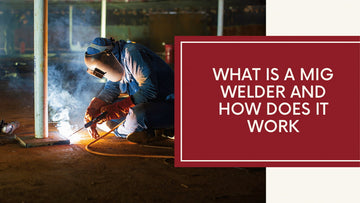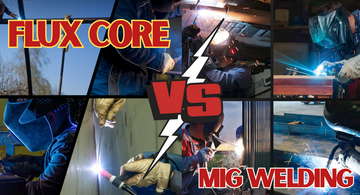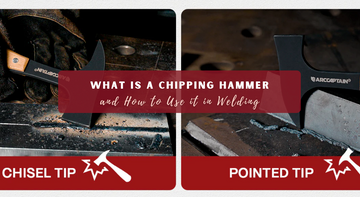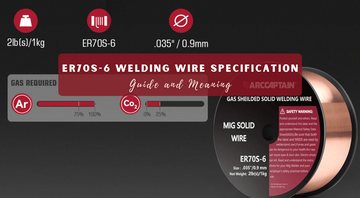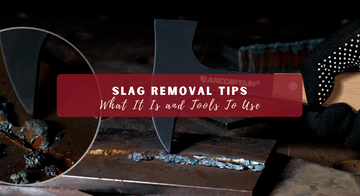Many people ask, 'What is a MIG welder and how does it operate?' This article is your comprehensive guide to understanding a MIG welder, a popular tool in the welding world. We'll explain its functions, how it works, and why it's a preferred choice for both beginners and experienced welders. Get ready to dive into the world of MIG welding and discover its efficiency and versatility.
What is MIG Welding?
MIG welding, also known as Metal Inert Gas welding, is a welding process that uses a welding gun to feed a wire electrode through a spool and into the weld pool. The wire electrode melts and joins two pieces of metal together. MIG welding is commonly used in manufacturing and construction because it is a fast and efficient welding process.
Basics of MIG Welding
MIG welding is a relatively simple welding process that requires a welding machine, a welding gun, a wire feeder, and a ground clamp. The welding machine provides the electrical current that melts the wire electrode and fuses the two pieces of metal together. The welding gun is used to direct the wire electrode into the weld pool. The wire feeder feeds the wire electrode through the spool and into the welding gun. The ground clamp is used to complete the electrical circuit and provide a path for the electrical current to flow through the metal.
MIG Welding Equipment
There are different types of MIG welders available in the market. Some are portable and affordable, while others are heavy and automatic. MIG welders can be either gasless or use shielding gas. Gasless MIG welders use flux-cored wire, which provides the shielding gas and flux to the weld pool. Shielding gas MIG welders use an inert gas, such as argon or helium, to protect the weld pool from atmospheric contamination.
Types of MIG Welders
MIG welders can be classified based on their power source, wire feeder, and welding capabilities. Some common types of MIG welders include:
- Transformer-based MIG welders: These welders use a transformer to convert the input voltage to the required welding voltage. They are simple and reliable but are not suitable for heavy-duty welding.
- Inverter-based MIG welders: These welders use an inverter to convert the input voltage to the required welding voltage. They are more efficient and can handle heavy-duty welding.
- Synergic MIG welders: These welders have a built-in microprocessor that automatically adjusts the welding parameters based on the wire feed speed and voltage. They are easy to use and produce consistent welds.
In conclusion, MIG welding is a widely used welding process that is fast and efficient. It requires a welding machine, a ArcCaptain MIG welding gun, a wire feeder, and a ground clamp. MIG welders can be portable, affordable, heavy, or automatic, and can use either gasless or shielding gas.
MIG Welding Materials
MIG welding is a versatile welding process that can be used to weld a variety of metals. The process involves feeding a consumable wire electrode through a welding gun and into the weld pool. The wire melts and fuses the two metal pieces together. MIG welding is commonly used in the automotive, construction, and manufacturing industries due to its speed and efficiency.
Metals Compatible with MIG Welding
MIG welding can be used to weld a wide range of metals, including steel, aluminum, stainless steel, copper, mild steel, carbon steel, magnesium, and nickel. Each metal has its own unique properties and requires different welding techniques and settings.
Steel is the most commonly welded metal with MIG welding due to its strength and durability. Aluminum is also commonly welded with MIG welding, but requires a higher level of skill due to its tendency to warp and crack. Stainless steel is another popular metal for MIG welding due to its corrosion resistance and strength.
Consumables and Filler Materials
MIG welding requires consumables and filler materials to create a strong weld. The consumables include a spool of wire, either ArcCaptain flux core or solid wire, and a shielding gas. The shielding gas protects the weld from contamination and oxidation.
Filler material is used to fill gaps between metal pieces and strengthen the weld. The filler material can be in the form of a consumable wire or a separate filler rod. The filler material should be compatible with the metal being welded and the welding process being used.
In conclusion, MIG welding is a versatile welding process that can be used to weld a variety of metals. The process requires the use of consumables and filler materials to create a strong weld. It is important to choose the right materials for the metal being welded and the welding process being used to ensure a successful weld.
How MIG Welding Works?
MIG welding, also known as Gas Metal Arc Welding (GMAW), is a welding process that uses an electrical arc to melt and join metal pieces together. In this process, a wire electrode is fed through a welding gun and is melted by an electrical arc, which creates a pool of molten metal that cools to form a joint.
Preparing for MIG Welding
Before starting the MIG welding process, it is important to take safety precautions. Welding safety equipment, such as a welding helmet, gloves, and protective clothing, should be worn to prevent burns and exposure to harmful fumes. The work area should also be well-ventilated to prevent inhalation of fumes.
It is also important to prepare the base metal for welding. This involves cleaning the metal surface with a wire brush to remove any rust, dirt, or oil that could affect the quality of the weld. Beveling the edges of the metal pieces can also help create a stronger weld.
Executing the Weld
To execute the MIG weld, the welding gun should be held at a 90-degree angle to the metal surface. The wire feed rate and gas flow rate should be adjusted according to the thickness of the metal being welded. The electrical arc is initiated by pressing the trigger on the welding gun, which melts the wire electrode and creates a pool of molten metal.
The heat input and feed rate should be carefully controlled to prevent overheating or underheating of the metal. The contact tip of the welding gun should be kept clean to ensure a smooth flow of the wire electrode. The welding technique should be adjusted according to the type of metal being welded, with different techniques required for welding aluminum and sheet metal.
Post-Welding Procedures
After completing the weld, it is important to clean the weld area to remove any spatter or slag that may have formed during the welding process. The weld should also be inspected for any defects, such as cracks or porosity, which can weaken the joint.
In conclusion, MIG welding is a versatile welding process that can be used to join a variety of metal types and thicknesses. With proper safety precautions and preparation, along with careful control of the welding parameters, high-quality welds can be achieved.
MIG Welding Gases - Common Shielding Gases
MIG welding is a process that uses a gas shield to protect the weld from atmospheric contamination. The most common shielding gases used in MIG welding are argon, carbon dioxide, and helium. Argon is an inert gas that is often used for welding non-ferrous metals like aluminum and copper. Carbon dioxide is a reactive gas that produces a deeper penetration and higher welding speeds than argon. Helium is a lighter gas that is often used in combination with argon or carbon dioxide to produce a hotter arc and deeper penetration.
Gas Selection and Effects
The selection of the shielding gas used in MIG welding can have a significant impact on the quality and appearance of the weld. The choice of gas depends on the material being welded, the desired welding speed, and the desired appearance of the weld. For example, using a higher percentage of carbon dioxide in the shielding gas can lead to a more spattering and a rougher weld appearance. On the other hand, using a higher percentage of argon in the shielding gas can produce a smoother weld appearance.
In addition to the commonly used gases, other gases like oxygen, nitrogen, and hydrogen can also be used in MIG welding. Oxygen can be added to the shielding gas to improve the weld quality and increase the welding speed. Nitrogen is sometimes added to the shielding gas to improve the arc stability and reduce spattering. Hydrogen can be added to the shielding gas to increase the heat input and improve the weld penetration.
Overall, the choice of shielding gas used in MIG welding depends on the specific requirements of the welding job. The versatility of MIG welding allows for a wide range of gases to be used, giving welders the flexibility to choose the best gas for their specific application.
Advantages and Considerations of Mig Welding
MIG welding, also known as Gas Metal Arc Welding (GMAW), is a welding process that utilizes a wire electrode and a shielding gas to join two pieces of metal together. MIG welding offers several advantages over other welding processes.
One of the main benefits of MIG welding is its productivity. MIG welding is a fast and efficient process that allows for high welding speeds and increased productivity. This makes it an ideal choice for high-volume welding applications.
Another advantage of MIG welding is its versatility. MIG welding can be used to weld a wide range of materials, including aluminum, stainless steel, and mild steel. This makes it a popular choice for a variety of industries, including automotive, construction, and manufacturing.
MIG welding machines are also relatively easy to use, making them a popular choice for both novice and experienced welders. In addition, MIG welding produces minimal spatter, which reduces the need for cleanup and post-welding finishing.
Challenges and Limitations
While MIG welding offers several advantages, there are also some challenges and limitations to consider. One of the main challenges of MIG welding is its portability. MIG welding machines require a power supply, which can make them difficult to use in remote locations or areas without access to electricity.
Another limitation of MIG welding is the cost of welding equipment. MIG welding machines can be expensive, which may make them cost-prohibitive for some businesses or individuals.
In addition, MIG welding may not be the best choice for all welding applications. For example, MIG welding may not be suitable for welding thick materials or for welding in tight spaces.
Overall, MIG welding offers several advantages over other welding processes, including high productivity, versatility, and minimal spatter. However, it is important to consider the challenges and limitations of MIG welding before deciding if it is the right choice for a particular welding application.
Applications of MIG Welding
MIG welding is a versatile welding process that is used in a wide range of applications. Here are some of the common applications of MIG welding:
Manufacturing
MIG welding is widely used in the manufacturing industry for the production of metal products. It is used to weld various types of metals, including steel, aluminum, and stainless steel. The process is highly efficient and produces high-quality welds, making it ideal for mass production.
Professionals
MIG welding is a popular welding technique among professionals due to its ease of use and versatility. It is commonly used in the automotive and construction industries, as well as in metal fabrication and repair work. MIG welding is also used in the aerospace industry for the production of aircraft parts.
Beginners
MIG welding is an excellent welding technique for beginners due to its ease of use. It is a relatively simple process that involves feeding a wire electrode through a welding gun and into the weld pool. The process produces a smooth and consistent weld, making it easy for beginners to learn.
Welding Techniques
MIG welding is a type of arc welding that uses a shielding gas to protect the weld from atmospheric contamination. The process produces a high-quality weld with minimal spatter and distortion. MIG welding can be used in both manual and automated welding applications.
TIG Welding
TIG welding is a similar welding process to MIG welding, but it uses a non-consumable tungsten electrode to produce the arc. TIG welding is commonly used to weld thin materials, such as aluminum and stainless steel, and produces a high-quality weld with minimal distortion.
Stick Welding
Stick welding is another type of arc welding that uses a consumable electrode to produce the arc. Stick welding is commonly used in construction and repair work and is suitable for welding thick materials.
Aluminum Welding
MIG welding is an excellent welding technique for welding aluminum. However, it requires a special type of wire and a shielding gas that is specifically designed for aluminum welding. MIG welding produces a high-quality weld with minimal distortion, making it ideal for welding aluminum.
Choosing the Right MIG Welder
When it comes to choosing the right MIG welder, there are a few key factors to consider. First and foremost, it's important to think about the type of welding you'll be doing. If you're primarily welding aluminum, for example, you'll want to choose a machine that's specifically designed for that type of welding.
Another important factor to consider is affordability. While there are certainly high-end welding machines out there, there are also plenty of affordable options that can still get the job done. It's important to strike a balance between cost and quality, and to choose a machine that fits within your budget without sacrificing too much in terms of performance.
When it comes to the physical characteristics of the welder, weight is an important consideration. A light machine can be easier to maneuver and transport, which can be especially important if you'll be taking your welding work on the go. However, it's also important to make sure that the machine is sturdy and well-built, as this will help ensure that it lasts for years to come.
Finally, welding safety is always a top priority. When choosing a MIG welder, it's important to look for features like an ArcCaptain auto-darkening welding helmet, which can help protect your eyes from the bright light produced during welding. Additionally, be sure to follow all proper safety precautions when using your welding machine, including wearing appropriate clothing and safety gear, and working in a well-ventilated area.
Frequently Asked Questions
How does MIG welding differ from other welding techniques?
MIG welding is a type of arc welding that uses a continuously fed wire electrode to join two pieces of metal. This technique differs from other welding techniques such as TIG welding and stick welding, which use different types of electrodes and welding processes. MIG welding is known for its speed and ease of use, making it a popular choice for both beginner and professional welders.
What are the primary applications of MIG welders in industry?
MIG welding is widely used in industry for a variety of applications, including automotive manufacturing, shipbuilding, and construction. It is particularly useful for welding thin materials, such as sheet metal, and for welding materials that are difficult to weld using other techniques.
What are the advantages of using MIG welding over TIG welding?
MIG welding has several advantages over TIG welding, including its speed, ease of use, and ability to weld a wider variety of materials. MIG welding is also more forgiving of operator error, making it a good choice for beginner welders. However, TIG welding is generally considered to produce higher quality welds and is often used for precision welding applications.
What types of materials can be welded using a MIG welder?
MIG welding can be used to weld a wide variety of materials, including carbon steel, stainless steel, aluminum, and copper. However, the specific type of wire and shielding gas used will depend on the material being welded.
What is the role of shielding gas in MIG welding?
Shielding gas is used in MIG welding to protect the weld from atmospheric contamination, such as oxygen and nitrogen, which can cause porosity and other defects in the weld. The type of shielding gas used will depend on the material being welded and the specific welding application.
What are the basic setup steps for a beginner using a MIG welder?
The basic setup steps for a beginner using a MIG welder include selecting the appropriate wire and shielding gas, setting the wire feed speed and voltage, and adjusting the welding gun angle and travel speed. It is important to follow the manufacturer's instructions and safety guidelines when setting up and using a MIG welder.

